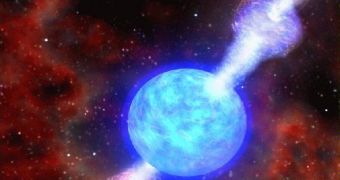The most powerful gamma-ray emission ever seen in the universe was detected yesterday by the Swift satellite, and originated from an area of space more than seven thousand times further away than the distance to the Andromeda galaxy. It was probably created by a massive star in the final stages of life that collapsed into a black hole. University of Leicester researchers say that the brightness of the GRB exceeded that of the whole Milky Way more than five million times!
Even though the distance to the newly created black hole is so great, if we had been able to see in the gamma-ray wavelengths the burst would have been clearly visible with the naked eye, without any optical instruments such as binocular or even telescopes.
Usually, the Swift satellite detects a gamma-ray burst once every week, however during the massive release of energy yesterday the satellite detected five of these bursts in less than 24 hours. Lead investigator for the Swift UK Science Data Center, Dr Julian Osborne from the University of Leicester said "It's great to find so many GRBs in one day, and the discovery of the brightest burst ever see will allow us to explore this incredible explosion in exquisite detail."
Soon after detecting the first burst, the Swift satellite turned towards the source of the emission. The collapsing star which determined it lies more than 20 billion light years away from Earth; however it was so powerful that it could still be seen with the naked eye.
It looks like the emission has passed its peak brightness and is now fading away. Amongst some of the teams participating in the observation of the unique event, aside that of University of Leicester, were those of Gemini-North Telescope in Hawaii and of Liverpool John Moores University with the help of Liverpool Telescope.
Professor Nial Tanvir from the University of Leicester said: "Our Gemini observations allowed us to measure the distance to the GRB, and to investigate the behaviour of gas close to the burst as it was blasted by the energy of the explosion".

 14 DAY TRIAL //
14 DAY TRIAL //